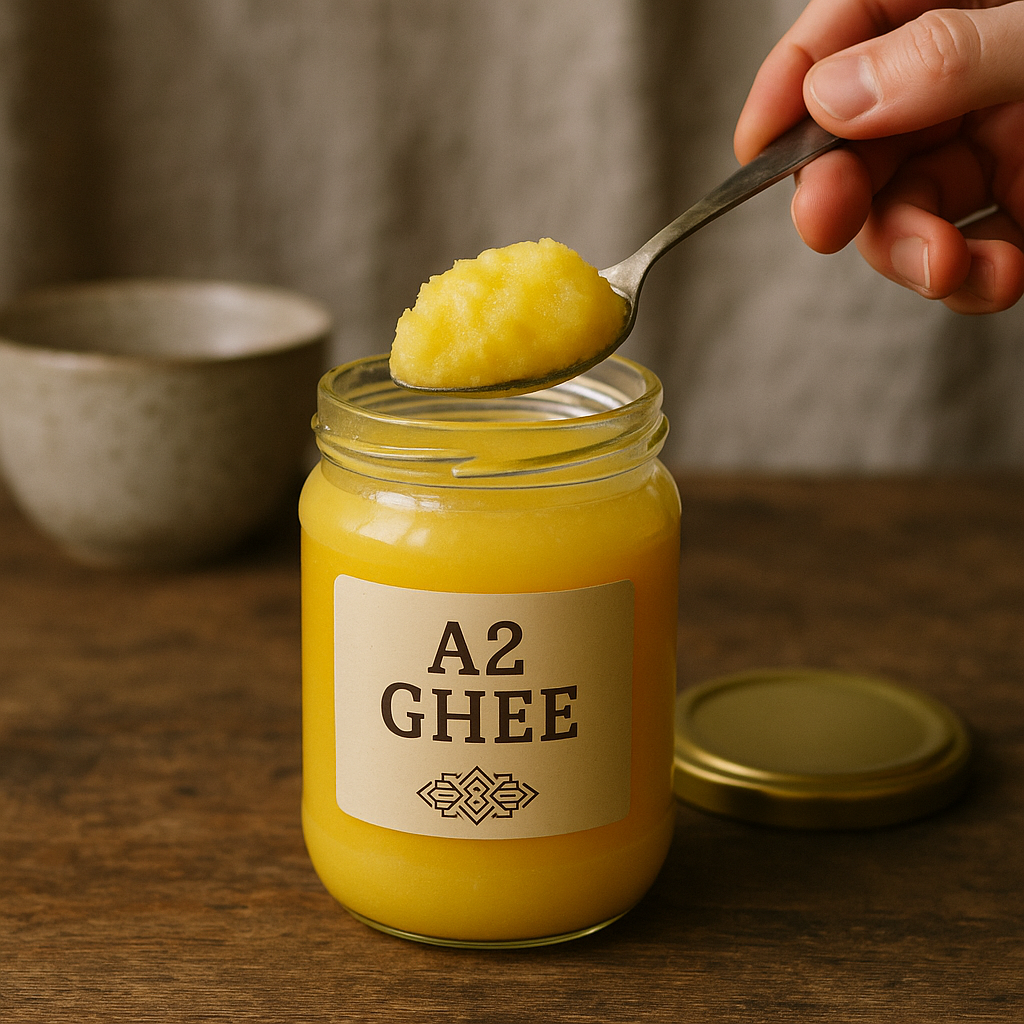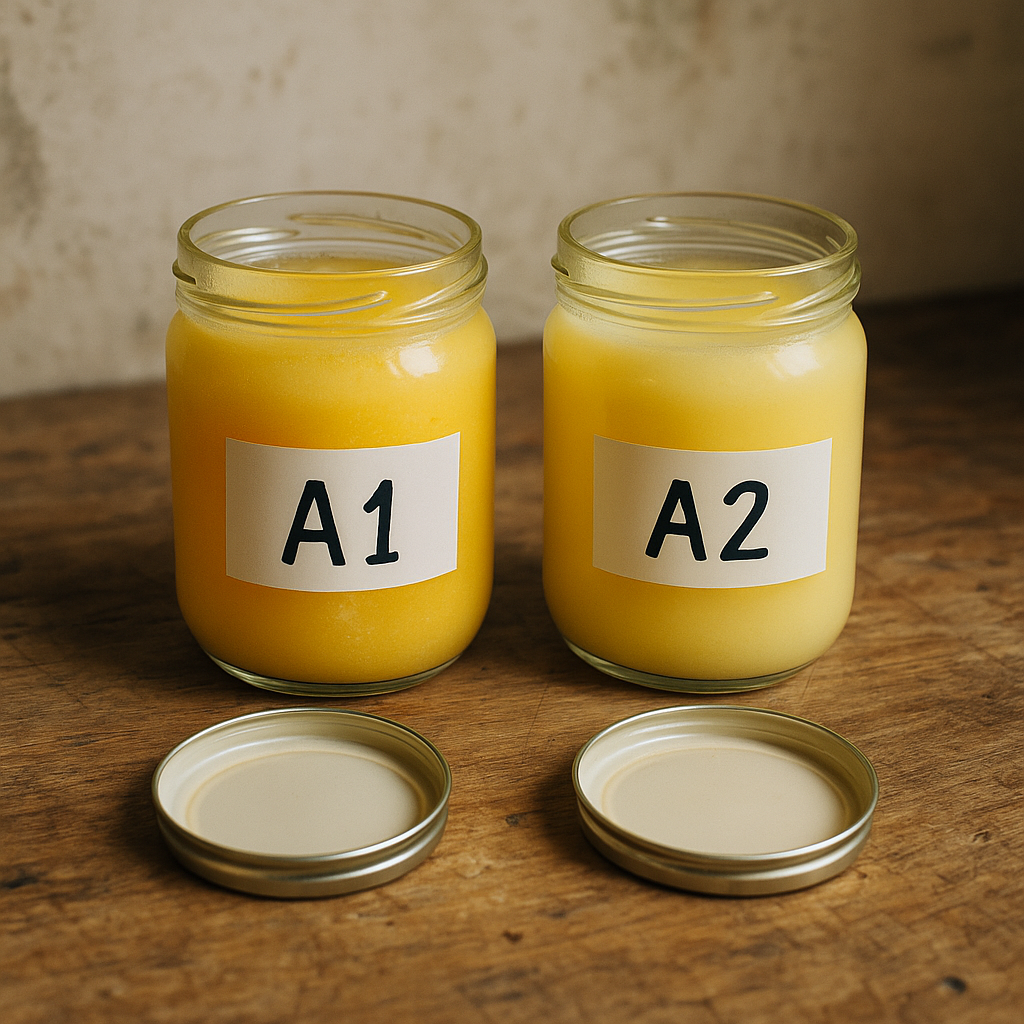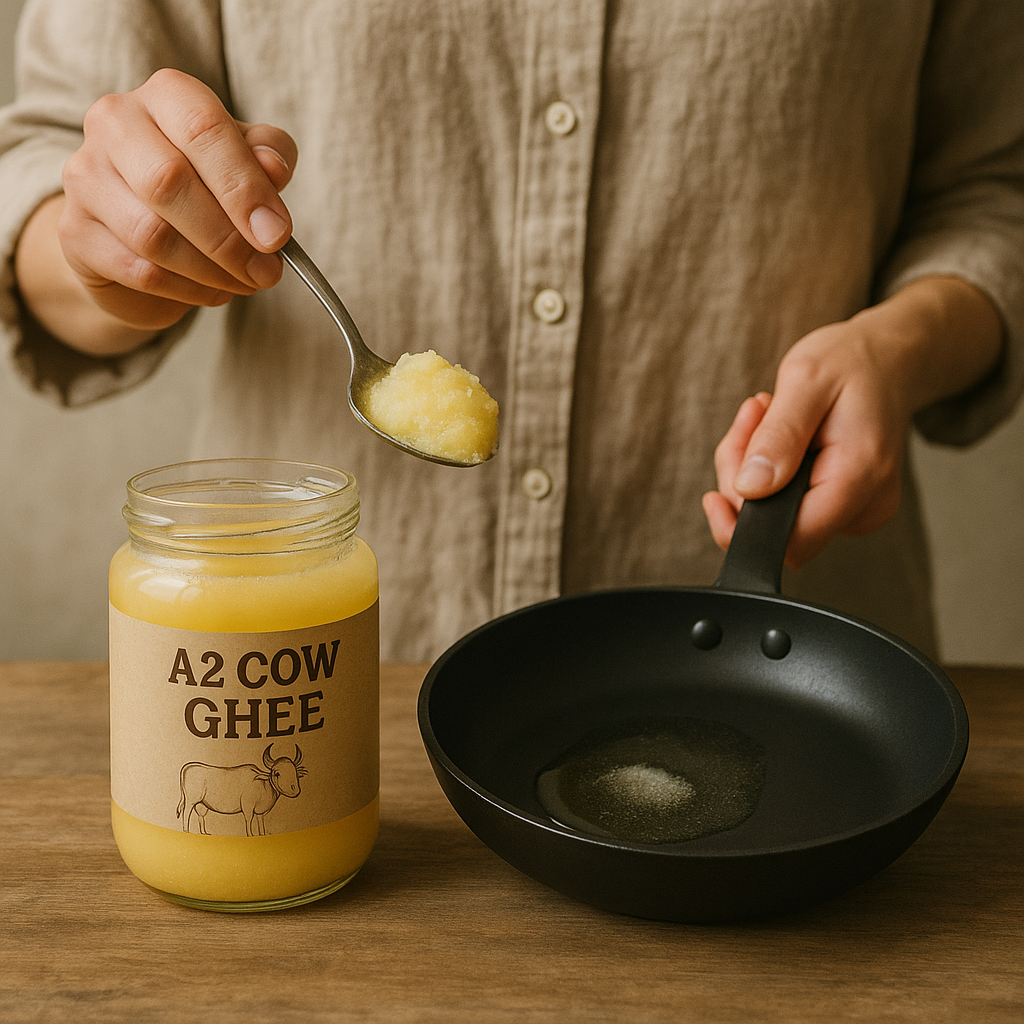आयुर्वेदिक डॉक्टर से प्रश्न पूछें और निःशुल्क या भुगतान मोड में अपनी चिंता की समस्या पर ऑनलाइन परामर्श प्राप्त करें। 2,000 से अधिक अनुभवी डॉक्टर हमारी साइट पर काम करते हैं और आपके प्रश्नों का इंतजार करते हैं और उपयोगकर्ताओं को उनकी स्वास्थ्य समस्याओं को हल करने में प्रतिदिन मदद करते हैं।
अभी हमारे स्टोर में खरीदें
A2 घी क्या है: आयुर्वेदिक मतलब, फायदे, और इसे कैसे बनाया जाता है

आजकल A2 घी काफी चर्चा में है — और इसके पीछे वाजिब कारण हैं। लेकिन A2 घी आखिर है क्या? और क्यों इतने लोग अपने सामान्य खाना पकाने के तेल और वसा को इस सुनहरे, सुगंधित पदार्थ से बदल रहे हैं? यह शब्द वैज्ञानिक लग सकता है, लेकिन इसकी जड़ें प्राचीन परंपरा में हैं। आयुर्वेद में, यह सिर्फ रसोई का एक हिस्सा नहीं है — यह दवा, पोषण और यहां तक कि एक आध्यात्मिक तत्व है। अगर आप A2 घी का मतलब, इसे कैसे बनाया जाता है, या A2 गाय के घी के फायदे के बारे में जानने के इच्छुक हैं, तो आप सही जगह पर हैं। आइए इसे सरल और स्पष्ट तरीके से समझते हैं, भले ही आप घी की दुनिया में नए हों।
हम A1 और A2 घी के बीच का अंतर, घी कैसे पारंपरिक रूप से बनाया जाता है, और इसे दैनिक जीवन में उपयोग करने के कई तरीकों को भी समझेंगे। स्पॉइलर: यह सिर्फ खाना पकाने के लिए नहीं है!

A2 घी क्या है: अर्थ और आयुर्वेदिक दृष्टिकोण
अगर आप सोच रहे हैं “A2 घी क्या है?” — तो यहां इसे समझने का एक सीधा तरीका है।
A2 घी का मतलब है उस मक्खन से बना घी जो A2 बीटा-कैसिइन प्रोटीन उत्पन्न करने वाली गायों के दूध से बनाया जाता है — आमतौर पर भारतीय नस्लों जैसे गिर, साहीवाल, या रेड सिंधी। इन गायों को आनुवंशिक रूप से बदला नहीं गया है और इनके दूध को अधिक पाचनीय और हमारे पूर्वजों द्वारा उपभोग किए गए दूध के करीब माना जाता है।
आयुर्वेद में, A2 गाय का घी सिर्फ वसा से अधिक है। इसे “घृत” कहा जाता है और इसे ओजस को पोषण देने की क्षमता के लिए सम्मानित किया जाता है — वह महत्वपूर्ण ऊर्जा जो प्रतिरक्षा, जीवन शक्ति और मानसिक स्पष्टता को नियंत्रित करने में विश्वास की जाती है। आयुर्वेदिक ग्रंथों में घी को सात्विक भोजन के रूप में वर्णित किया गया है — शांत, पोषणकारी और शुद्धिकरण। इसका उपयोग खाना पकाने, हर्बल दवा, मालिश और यहां तक कि पवित्र अनुष्ठानों में किया जाता है।
अन्य वसाओं के विपरीत, घी अमा (विषाक्त पदार्थ) नहीं बढ़ाता, आयुर्वेद के अनुसार। इसके बजाय, यह अग्नि — आपके पाचन अग्नि का समर्थन करता है। यही कारण है कि कई आयुर्वेदिक डॉक्टर सुबह में गर्म घी का एक चम्मच जड़ी-बूटियों के साथ या खाली पेट लेने की सलाह देते हैं।

A2 बनाम A1 घी: मुख्य अंतर
आइए असली मुद्दे पर आते हैं: A1 और A2 घी के बीच का अंतर। मुख्य अंतर उस दूध में प्रोटीन के प्रकार में है जिसका उपयोग किया जाता है।
-
A1 घी उन गायों के दूध से बनाया जाता है जैसे होल्स्टीन और जर्सी, जो पश्चिमी डेयरी फार्मों में आम हैं। इसमें A1 बीटा-कैसिइन होता है, जो कुछ अध्ययनों के अनुसार संवेदनशील व्यक्तियों में सूजन या पाचन असुविधा का कारण बन सकता है।
-
A2 घी, दूसरी ओर, देशी गायों से आता है और केवल A2 प्रोटीन होता है, जिसे कई लोग पेट के लिए आसान और मानव पाचन के साथ अधिक संगत मानते हैं।
वैज्ञानिक दुनिया में अभी भी बहस जारी है, लेकिन अनुभवजन्य साक्ष्य और आयुर्वेदिक परंपरा A2 दूध और घी के फायदों की ओर दृढ़ता से इशारा करते हैं।
A2 गाय के घी का असली मतलब
तो जब कोई पूछता है, “A2 गाय का घी क्या है?”, तो सरल उत्तर है: यह A2 दूध से बना घी है — और पारंपरिक तरीकों से सही तरीके से बनाया गया है।
लेकिन यहां यह जटिल हो जाता है — सभी ब्रांड जो अपने लेबल पर “A2” लगाते हैं, वे प्रामाणिक प्रथाओं का पालन नहीं करते। असली A2 घी आमतौर पर बिलोना विधि से बनाया जाता है (हम इसके बारे में आगे बात करेंगे), घास-खाने वाली गायों से, और नैतिक दुग्ध प्रक्रिया के साथ।
ओह, और इसे स्पष्ट करने के लिए: A2 घी का मतलब सिर्फ एक ट्रेंडी लेबल से अधिक है। यह शुद्धता, परंपरा और स्वास्थ्य के बारे में है — सिर्फ मार्केटिंग प्रचार नहीं।
A2 घी कैसे बनाया जाता है: पारंपरिक तैयारी विधियाँ
तो अब जब हमने समझ लिया कि A2 घी का मतलब क्या है, तो आइए देखें कि इसे वास्तव में कैसे बनाया जाता है — वास्तविक तरीके से।
प्रामाणिक A2 घी बिलोना विधि का उपयोग करके तैयार किया जाता है, जो आयुर्वेदिक ग्रंथों में वर्णित एक प्राचीन तकनीक है। यह एक धीमी, सावधानीपूर्वक प्रक्रिया है जो मात्रा से अधिक गुणवत्ता को प्राथमिकता देती है। यहां यह आमतौर पर कैसे होता है:
-
देशी A2 गायों का दुग्ध – यह नैतिक रूप से प्राप्त दूध से शुरू होता है, जैसे गिर या साहीवाल। ये गायें आमतौर पर स्वतंत्र चराई करती हैं, घास खाती हैं, और हार्मोन इंजेक्शन या कठोर परिस्थितियों के अधीन नहीं होतीं।
-
दही बनाना – वाणिज्यिक घी के विपरीत, जो अक्सर चरणों को छोड़ देता है, A2 घी दूध को पहले दही (योगर्ट) में बदलकर बनाया जाता है।
-
हाथ से मथना – दही को लकड़ी के मथानी (पारंपरिक रूप से बिलोना कहा जाता है) का उपयोग करके मथा जाता है ताकि मक्खन अलग हो सके। यह चरण महत्वपूर्ण है — इसे धीरे-धीरे और ध्यानपूर्वक किया जाता है, आमतौर पर घड़ी की दिशा में और विपरीत दिशा में घुमावों में।
-
मक्खन को गर्म करना – अलग किए गए मक्खन को फिर नमी को हटाने के लिए धीमी आंच पर गर्म किया जाता है। यह धीमी-खाना पकाने का चरण सुगंध को बढ़ाता है, रंग को गहरा करता है, और पोषक तत्वों को संरक्षित करता है।
जो आपके पास बचता है वह है सुनहरा, सुगंधित घी जो अच्छे वसा, विटामिन और जैव सक्रिय यौगिकों से भरपूर होता है।
और हां — यह प्रक्रिया श्रम-साध्य और समय लेने वाली है। यही एक कारण है क्यों A2 घी इतना महंगा है। यह बड़े पैमाने पर उत्पादित नहीं होता; इसे प्यार से बनाया जाता है। आप कह सकते हैं कि यह वसाओं का क्राफ्ट बीयर है!

A2 घी के स्वास्थ्य लाभ
अब बात करते हैं परिणामों की। क्यों आपको अपने सामान्य खाना पकाने के तेल या मक्खन को इस “फैंसी” घी से बदलने की जहमत उठानी चाहिए? पता चलता है, A2 घी के फायदे (और विशेष रूप से A2 गाय के घी के फायदे) काफी प्रभावशाली हैं।
पाचन, मस्तिष्क, और प्रतिरक्षा के लिए
सबसे पहले, A2 घी पेट के लिए अनुकूल है। कई आधुनिक तेलों के विपरीत जो पेट की परत को परेशान करते हैं, घी इसे शांत करता है। A2 घी में मौजूद शॉर्ट-चेन फैटी एसिड जैसे ब्यूट्रेट स्वस्थ पाचन का समर्थन करते हैं और यहां तक कि आंत की दीवार को ठीक करने में मदद करते हैं। अगर आपने कभी सूजन या अम्लता का सामना किया है, तो अपने दाल या चावल में गर्म घी का एक चम्मच वास्तव में मदद कर सकता है।
मस्तिष्क के लिए, A2 घी रॉकेट ईंधन की तरह है। ओमेगा-3 और स्वस्थ कोलेस्ट्रॉल से भरपूर, यह मस्तिष्क की कोशिकाओं को पोषण देता है, स्मृति में सुधार करता है, और भावनात्मक संतुलन का समर्थन करता है। आयुर्वेद इसे छात्रों के लिए परीक्षा के दौरान भी सिफारिश करता है — है ना अद्भुत?
और प्रतिरक्षा को मत भूलिए। घी में संतृप्त वसा वसा-घुलनशील विटामिन (A, D, E, और K) को अवशोषित करने में मदद करते हैं, जो प्रतिरक्षा स्वास्थ्य में बड़ी भूमिका निभाते हैं। इसके अलावा, घी में मौजूद एंटीऑक्सीडेंट ऑक्सीडेटिव तनाव को कम करने में मदद करते हैं, जो एक फैंसी तरीका है यह कहने का कि वे आपके शरीर को आराम करने और बीमारी से लड़ने में मदद करते हैं।
बच्चों, त्वचा, और उम्र बढ़ने के समर्थन के लिए
बच्चों को विकास के लिए अच्छे वसा की जरूरत होती है — नहीं शर्करा युक्त स्नैक्स। A2 गाय का घी मस्तिष्क और हड्डियों के विकास के लिए सही प्रकार के वसा प्रदान करता है। उनके रोटियों या गर्म दूध में थोड़ा सा जोड़ें — यह एक पुरानी चाल है जो अभी भी काम करती है।
और आपकी त्वचा? घी अंदर से ही नहीं, बाहर से भी अच्छा है। इसे त्वचा पर लगाने से यह मॉइस्चराइज करता है, फटे होंठों को ठीक करता है, और यहां तक कि निशानों को हल्का करता है। कुछ लोग इसे प्राकृतिक एंटी-एजिंग क्रीम के रूप में कसम खाते हैं। (सावधान: चमत्कार की उम्मीद न करें, लेकिन हे, यह प्राकृतिक है।)
जहां तक उम्र बढ़ने की बात है, A2 घी की एंटीऑक्सीडेंट प्रोफाइल सेलुलर क्षति से लड़ने में मदद करती है। यह जोड़ों को चिकनाई देता है और हार्मोनल संतुलन का समर्थन करता है। सच में, यह एक चम्मच में प्रकृति का मल्टीविटामिन है।
ओह, और हां — घी के प्रकार मायने रखते हैं। क्लैरिफाइड बटर शेल्फ पर एक जैसा लग सकता है, लेकिन स्रोत, प्रक्रिया, और गाय की नस्ल सब कुछ बदल देती है। A2 साफ, कोमल, और हमारे शरीर के काम करने के तरीके के साथ अधिक संगत है।
A2 घी का दैनिक आहार में उपयोग और भंडारण कैसे करें
तो आपके पास A2 घी का जार है। अब क्या?
सौभाग्य से, घी कुछ इतना प्राकृतिक और स्थिर है — यह अविश्वसनीय रूप से बहुमुखी है। आप इसे पकाने में, सीधे खाने में, या यहां तक कि अपनी त्वचा पर लगाने में भी उपयोग कर सकते हैं। इसका धुआं बिंदु उच्च होता है (लगभग 485°F / 250°C), जो इसे तलने या सौते करने के लिए अधिकांश तेलों की तुलना में सुरक्षित बनाता है।
यहां A2 घी का उपयोग करने के कुछ सरल, रोजमर्रा के तरीके हैं:
-
पकाना और तलना: इसे स्टर-फ्राई, करी, या डोसा बैटर में तेल के बदले इस्तेमाल करें। यह एक मक्खन जैसी सुगंध जोड़ता है जो बस अलग है।
-
गर्म खाद्य पदार्थों पर डालना: इसे चावल, दाल, रोटी, या खिचड़ी पर डालें। एक चम्मच बहुत लंबा रास्ता तय करता है।
-
सुबह की रस्म: कुछ आयुर्वेदिक प्रथाएं आपके दिन की शुरुआत खाली पेट घी के एक चम्मच से करने की सिफारिश करती हैं — अक्सर हल्दी या गर्म पानी के साथ मिलाकर।
-
कॉफी/चाय में: हां, “बुलेटप्रूफ” घी कॉफी एक चीज है। अपने सुबह के पेय में आधा चम्मच जोड़ें उस क्रीमी ऊर्जा बूस्ट के लिए।
-
त्वचा की देखभाल: फटे होंठों या सूखी कोहनियों पर थोड़ा रगड़ें। अजीब लगता है, चमत्कार करता है।
इसे कैसे स्टोर करें?
अपने A2 घी को ठंडी, सूखी जगह पर स्टोर करें — फ्रिज की जरूरत नहीं। इसे कसकर बंद रखें और हर बार एक साफ, सूखा चम्मच इस्तेमाल करें। असली घी महीनों, यहां तक कि वर्षों तक खराब हुए बिना रहता है अगर सही तरीके से रखा जाए।
निष्कर्ष
तो — आइए इसे सब एक साथ जोड़ते हैं।
A2 घी का मतलब सिर्फ एक खाद्य प्रवृत्ति से अधिक है। यह आयुर्वेदिक चिकित्सा में गहरी जड़ें रखने वाला एक समय-सम्मानित, पोषक तत्वों से भरपूर वसा है। पाचन और मस्तिष्क के कार्य में मदद करने से लेकर प्रतिरक्षा को बढ़ावा देने और चमकदार त्वचा का समर्थन करने तक, A2 गाय के घी के फायदे व्यापक हैं।
A2 घी क्या है — और यह अपने A1 समकक्ष से कैसे अलग है — को समझना आपको अपने और अपने परिवार के लिए स्वस्थ, अधिक सूचित विकल्प बनाने की शक्ति देता है। चाहे आप इसे पकाने, पोषण करने, या ठीक करने के लिए उपयोग कर रहे हों, असली A2 घी अपनी शुद्धता, पारंपरिक जड़ों, और स्वास्थ्य मूल्य के लिए खड़ा है।
और देखिए, यहां पूर्णता लक्ष्य नहीं है। बस कुछ प्रसंस्कृत वसाओं को कुछ साफ और पोषक तत्वों से भरपूर चीजों के साथ बदलना वास्तविक अंतर ला सकता है। यही मूल बातों पर वापस जाने की सुंदरता है।
अक्सर पूछे जाने वाले प्रश्न
प्रश्न: क्या A2 घी सामान्य घी से बेहतर है?
उत्तर: आमतौर पर, हां। A2 घी देशी गायों के A2 प्रोटीन वाले दूध से बनाया जाता है, जिसे कई लोग पचाने में आसान पाते हैं। सामान्य घी A1 दूध से बनाया जा सकता है, जिसे कुछ लोग सूजन या सूजन का कारण मानते हैं।
प्रश्न: A2 घी इतना महंगा क्यों है?
उत्तर: क्योंकि यह कैसे बनाया जाता है। यह देशी भारतीय गायों के दूध का उपयोग करता है, पारंपरिक बिलोना प्रसंस्करण शामिल है, और कम मात्रा में उपज देता है। यह बड़े पैमाने पर उत्पादित नहीं होता है, और गुणवत्ता नियंत्रण बहुत सख्त होता है।
प्रश्न: A2 घी के दुष्प्रभाव क्या हैं?
उत्तर: जब तक आप डेयरी से एलर्जी नहीं हैं या इसे अत्यधिक बड़ी मात्रा में नहीं खा रहे हैं, दुष्प्रभाव दुर्लभ हैं। कहा जा रहा है, यह कैलोरी-घना है, इसलिए संयम महत्वपूर्ण है। इसके अलावा, हमेशा सुनिश्चित करें कि यह असली A2 घी है — कुछ ब्रांड इसे नकली बनाते हैं।
अंतिम विचार
अगर आपने इसे यहां तक पढ़ा है — तो सलाम। स्पष्ट रूप से, आप इस बात की परवाह करते हैं कि आपके शरीर में क्या जाता है, और यह गर्व की बात है।
चाहे आप यहां इसलिए हैं क्योंकि आपने A2 गाय के घी क्या है के बारे में किसी दोस्त से सुना, या आप बस अपनी पेंट्री को साफ करने की कोशिश कर रहे हैं — यह सुनहरी चीज एक छोटा लेकिन शक्तिशाली अपग्रेड है। इसे एक हफ्ते के लिए आजमाएं। अपने चावल, अपनी चाय, या अपनी त्वचा की दिनचर्या में एक चम्मच जोड़ें। अंतर महसूस करें। और हे, शायद इसे किसी ऐसे व्यक्ति को पास करें जो अभी भी रैंडम सीड ऑयल्स के साथ खाना बना रहा है 😬।
अधिक जानना चाहते हैं या प्रामाणिक A2 घी का एक जार लेना चाहते हैं? अपने पास के विश्वसनीय स्थानीय फार्मों या छोटे-बैच उत्पादकों की जांच करें — या ऑनलाइन नैतिक भारतीय डेयरी ब्रांडों का समर्थन करें।
👉 स्विच करने के लिए तैयार? एक चम्मच से शुरू करें। आपका शरीर आपको धन्यवाद देगा।
यह लेख वर्तमान योग्य विशेषज्ञों द्वारा जाँचा गया है Dr Sujal Patil और इसे साइट के उपयोगकर्ताओं के लिए सूचना का एक विश्वसनीय स्रोत माना जा सकता है।

